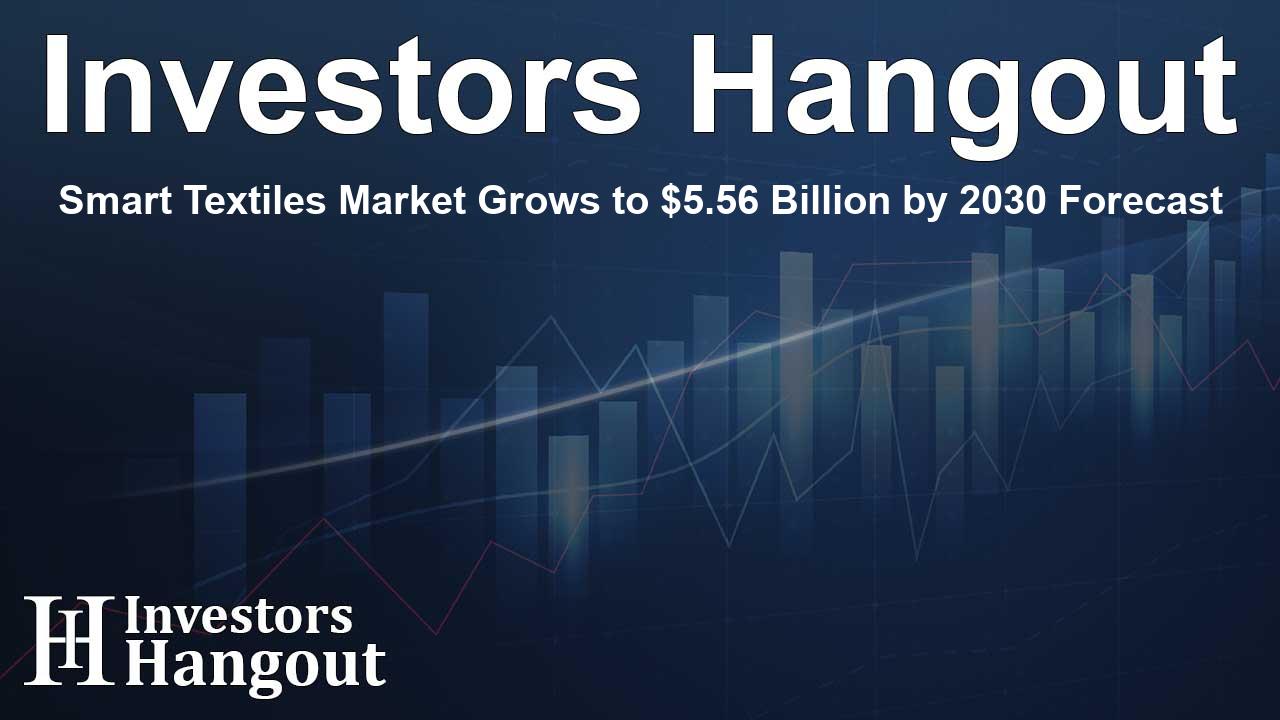Smart Textiles Market Grows to $5.56 Billion by 2030 Forecast

The Future of Smart Textiles: Growth and Innovations
The smart textiles market is on a promising trajectory, anticipated to reach a significant value of USD 5.56 billion by 2030. This market surge is driven by the integration of intelligent technologies within textiles, which respond dynamically to various stimuli, transforming traditional fabrics into multifunctional materials.
Market Overview and Projections
Currently valued around USD 2.41 billion, the smart textiles industry is expected to grow at a remarkable compound annual growth rate (CAGR) of 18.2%. The rapid expansion is largely attributed to increasing applications in diverse fields like healthcare, military, sports, and automotive industries. These textiles empower users with capabilities to monitor health metrics or enhance safety in critical environments.
Key Drivers of Market Expansion
The compelling demand for non-invasive wearable technologies is especially high in the healthcare sector, where smart textiles can monitor vital health metrics discreetly. This integration fosters a proactive approach to wellness, as patients are equipped with garments that monitor their conditions in real-time.
In military applications, there is a growing emphasis on enhancing the protective gear worn by soldiers. Smart fabrics can be engineered to offer additional safety features, such as temperature regulation and camouflage, improving soldier efficacy and safety. Meanwhile, the sports industry also benefits, as athletes increasingly adopt smart fabrics for better performance monitoring and injury prevention.
Emerging Applications and Innovations
Innovations in smart textiles include developments in energy-harvesting garments and textiles that monitor mental health, emphasizing the growing versatility of these materials. Additionally, the rise of artificial intelligence and machine learning enhances the performance and usability of smart apparel, enabling a seamless connection between technology and clothing.
Passive Smart Textiles: A Growing Segment
Among the various categories in the market, passive smart textiles have shown considerable promise due to their simplicity and cost-effectiveness. These materials do not require complex technology to function; instead, they leverage inherent properties such as conductive fibers or sensors, allowing for basic monitoring of environmental conditions.
Healthcare Sector and Future Opportunities
The healthcare vertical is projected to witness unprecedented growth, driven by a notable shift towards more personalized and efficient patient care solutions. Smart textiles equipped with biosensors are pivotal in this shift, allowing healthcare providers to monitor patients continuously without necessitating constant physical examinations.
Regional Highlights: Growth in Asia Pacific
The Asia Pacific region is poised to display the highest CAGR within the smart textiles market due to robust advancements in technology and a burgeoning consumer base eager for innovation. Countries like Japan and South Korea are leading investments in smart textile production, capitalizing on digital health trends and the growing importance of wearable technology in everyday life.
Market Challenges and Strategies
Despite the bright outlook, the smart textiles sector faces challenges chiefly relating to high production costs, which could impede broader market penetration. Moreover, while the opportunity for hybrid smart textiles exists, companies must focus on refining the balance between innovative features and affordability for widespread adoption.
Leading Players in the Smart Textiles Market
Key players shaping the smart textiles landscape include major companies known for their innovative approaches, such as DuPont and Jabil Inc., alongside emerging firms that prioritize smart technology integration in their textile offerings. As competition heats up, collaboration between technology leaders and textile manufacturers will likely drive further advancements in this field.
Frequently Asked Questions
What is the projected market value of smart textiles by 2030?
The smart textiles market is projected to reach USD 5.56 billion by 2030.
Which sectors are driving the growth of smart textiles?
Healthcare, military, sports, and automotive sectors are key drivers of smart textiles growth.
What are passive smart textiles?
Passive smart textiles incorporate sensors without active components, allowing for basic monitoring of external stimuli.
What is the expected CAGR for the smart textiles market?
The market is expected to grow at a CAGR of 18.2% during the forecast period.
Which region shows the highest growth potential in the smart textiles market?
The Asia Pacific region is anticipated to experience the highest CAGR due to technological advancements and strong demand.
About The Author
Contact Ryan Hughes privately here. Or send an email with ATTN: Ryan Hughes as the subject to contact@investorshangout.com.
About Investors Hangout
Investors Hangout is a leading online stock forum for financial discussion and learning, offering a wide range of free tools and resources. It draws in traders of all levels, who exchange market knowledge, investigate trading tactics, and keep an eye on industry developments in real time. Featuring financial articles, stock message boards, quotes, charts, company profiles, and live news updates. Through cooperative learning and a wealth of informational resources, it helps users from novices creating their first portfolios to experts honing their techniques. Join Investors Hangout today: https://investorshangout.com/
The content of this article is based on factual, publicly available information and does not represent legal, financial, or investment advice. Investors Hangout does not offer financial advice, and the author is not a licensed financial advisor. Consult a qualified advisor before making any financial or investment decisions based on this article. This article should not be considered advice to purchase, sell, or hold any securities or other investments. If any of the material provided here is inaccurate, please contact us for corrections.
